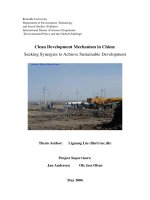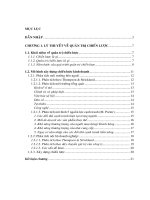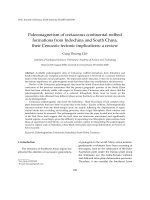cash holding china
Bạn đang xem bản rút gọn của tài liệu. Xem và tải ngay bản đầy đủ của tài liệu tại đây (145.54 KB, 7 trang )
344
The Determinants of Cash Holdings: Evidence from Chinese Listed
Companies
LI Wenyao
School of Economics and Management, Wuhan University, P.R.China, 430072
Abstract Using system generalized method of moments(GMM) estimation, this study estimates a
dynamic cash holdings model on a panel dataset
of 465 firms from Chinese Stock Markets for the
1998-2003 period. The results show that there are significant dynamic effects in the determination of
firms’ cash holdings. In addition, it provides evidence that cash flows, growth opportunities and size of
firms exert positive impacts on their cash holdings, while non-cash liquid assets and leverage exert
negative impacts on cash holdings. Most of the variables that are relevant for explaining cash holdings
in the United States and European countries are also relevant in China.
Key words Cash holdings, Dynamic model, Panel data, Generalized method of moments Agency
costs
1 Introduction
Why do corporates hold large amounts of cash? And is there an optimal level of cash holdings? It is
argued that management that maximizes shareholder wealth should set the firm's cash holdings at a level
such that the marginal benefit of cash holdings equals the marginal cost of those holdings. The cost of
holding cash includes the lower rate of return of these assets and possibly higher taxation. In addition,
cash holdings may cause severe agency problems, for example, management may hold cash to pursue its
own objectives at shareholder expense. There are two main motives (benefits) from holding cash, one is
transaction cost motive and the other is precautionary motive. Transaction cost motive means that the
firm saves transaction costs to raise funds and does not have to liquidate assets to make payments.
Precautionary motive means that the firm can use the cash holdings to finance its activities and
investments if other sources of funding are not available or are excessively costly.
Our knowledge about cash holdings has mostly been derived from data from developed economies that
have many institutional similarities. Kim, Mauer and Sherman analysed the determinants of cash
holdings for a sample of US companies. They report that firms facing higher costs of external financing,
having more volatile earnings, and those firms with relatively lower returns on assets hold significantly
larger liquid assets.
[1]
For similar firms, Opler, Pinkowitz, Stulz and Williamson provide evidence that
small firms and firms with strong growth opportunities and riskier cash flows hold relatively high ratios
of cash to total non-cash assets, and firms that have the greatest access to the capital markets, such as
large firms and those with high credit ratings, tend to hold lower ratios of cash to total non-cash assets.
[2]
Pinkowitz and Williamson examine the cash holdings of firms from the United States, Germany, and
Japan . In addition to the findings similar to those in Opler, they document that the monopoly power of
banks has a significant impact on cash balance.
[3]
Ozkan investigated the empirical determinants of
corporate cash holdings for a sample of UK firms. They suggest that ownership structure of firms plays
an important role in determining cash holdings of UK companies. And they also reveal that firms’
growth opportunities, cash flows, liquid assets, leverage and bank debt are important in determining
cash holdings.
[4]
The purpose of this paper is to analyze the cash holdings choices made by companies from China that
have different institutional structures.
In this paper dynamic cash holdings model is estimated on a panel dataset of 465 firms from Chinese
Stock Markets for the 1998-2003 period. The main contribution of the paper is that the panel structure of
the dataset is exploited by estimating a dynamic model using the system generalized method of
moments(GMM) estimator suggested by Arellano and Bover, Blundell and Bond which takes account of
unobserved heterogeneity between firms, endogeneity of the lagged dependent variable as well as
possible endogeneity of the explanatory variables.
[5,6]
This is an important extension of earlier studies of
345
determinants of cash holdings which implicitly assumes that firms can instantaneously adjust towards
the target cash level following changes in firm-specific characteristics or random shocks.
The paper is organized as follows. The next section discusses the relevant theory and derives the
empirical hypotheses; Section 3 describes the data collection; The empirical methodology and
estimation results are discussed in Section 4 and Section 5; Section 6 draws conclusions.
2 Cash holdings hypotheses
Based on agency theory, asymmetric information theory, static tradeoff theory and financing hierarchy
theory, this section discusses the possible relations between cash holding and seven other firm-specific
characteristics. Throughout this paper, cash is defined as the ratio of cash and cash equivalents to total
assets.
2.1 Cash flows
According to pecking order or financing hierarchy theory, firms prefer internal finance to external
finance. Therefore, firms that have higher cash flows are expected to hold larger amounts of cash as a
resourse of internal funds. We use the ratio of cash flows to total assets as a proxy for the cash flows. A
positive relation between cash holdings and cash flows is expected.
2.2 Non-cash liquid assets
It has been argued that non-cash liquid assets is a substitute for holding cash.
[2,4]
Transaction cost will
arise when converting non-cash assets into cash in an imperfect market. It is reasonable to assume that
the cost of converting non-cash liquid assets into cash is much lower as compared with other assets.
Firms with sufficient liquid assets can liquidate non-cash liquid assets at low cost to raise funds when
they have a shortage of cash. The proxy we use for non-cash liquid assets is the ratio of net working
capital minus cash to total assets. We expect a negative relation between cash holdings and non-cash
liquid assets.
2.3 Leverage
Firms can use borrowing as a substitute for holding cash because leverage can act as a proxy for the
ability of firms to issue debt. Moreover, the cost of funds used to invest in liquidity increases as the ratio
of debt financing increases, which would imply a reduction in cash holdings with increased leverage.
Therefore, we expect a negative relation between the firm’s cash holdings and its leverage.
However, because of the existence of agency costs of debt, highly leveraged firms find it difficult and
expensive to raise additional funds. These firms also sometimes find it impossible to renegotiate existing
debt agreements to prevent default and bankruptcy. Such firms have high incentives to hold larger cash.
In addition, we should note that higher debt levels can increase the likelihood of financial distress,
therefore, we would expect a firm with a high leverage to increase its cash holdings to decrease the
likelihood of financial distress. Accordingly, we would induce a positive relation between cash holdings
and leverage.
Leverage is measured by the ratio of total debt to total assets.
2.4 Bank debt
Because of the comparative advantage of banks in monitoring firms’ activities and in collecting and
processing information, It is often argued that bank financing is more effective than public debt in
reducing problems associated with agency conflicts and informational asymmetry. Thus, the existence of
a bank relationship would enhance the ability of firms to raise external finance through providing signals
about the borrowing firms’ credit worthiness. Moreover, bank debt can serve as a substitute for holding
high levels of cash because bank debt is more easily renegotiated when firms need to.
[4]
These
arguments suggest that firms with more bank debt are expected to hold less cash. We measure bank debt
as the ratio of total bank debt to total debt. And we expect a negative relation between cash holdings and
bank debt.
2.5 Growth opportunities
Asymmetric information between insider and outside investors makes external financing more
expensive. Myers and Majluf argue that firms whose values are largely determined by growth
opportunities face more severe asymmetric information problem
[7]
. Hence firms with higher growth
346
opportunities would hold larger amounts of cash. Therefore ,we expect a positive relation between cash
holdings and growth opportunities.
However, according to financing hierarchy theory, a firm that invests more should have fewer internal
resources, and hence would accumulate less cash. This induces a negative relation between cash
holdings and growth opportunities.
Growth opportunities is measured by the ratio of price per share to book value per share.
2.6 Size
It is suggested that large firms have less information asymmetry than small firms. Therefore, small firms
face more borrowing constraints and higher costs of external financing than large firms. In addition, the
cost of external financing is smaller for larger firms because of scale economies resulting from a
substantial fixed cost component of security issuance costs. All these would in turn imply that small
firms should hold more cash. The size of firms is measured by the natural logarithm of total assets. We
expect a negative relation between cash holdings and the size of firms.
2.7 Return on assets
The attractiveness of investment in physical assets lies in the high return on assets, a negative relation
between cash holdings and return on assets is predicted. We measure return on assets by the ratio of net
profits to the book value of assets.
3 Data collection
To investigate our hypotheses on the determinants of cash holdings, we gather a sample of firms from
the Shanghai Wind Information database for the 1998-2003 period.
There are two stock exchanges in China, the Shanghai Stock Exchange (SHSE) and the Shenzhen Stock
Exchange (SZSE), both beginning to operate in December 1990. One characteristic of the Chinese stock
market is market segmentation. In addition to the issuing of A-shares which are restricted to Chinese
citizens, since 1992 China’s equity markets opened to international investors with the issuing of
B-shares.
The sample selection starts with the entire population of listed Chinese firms with A-shares on the SZSE
and SHSE for 1998–2003. Years prior to 1998 are excluded from our sample because the disclosure of
cash flows was not required until 1998 when the Statement of Changes in Financial Position was
mandated. For each of 1998–2003, annual financial data and the equity prices data of the sample firms
are obtained from the Shanghai Wind Information database. In order to estimate our dynamic panel data
model, we need complete financial and market data for several years, so the sample firms we select
should go to public before 1998. In the above sample firms, financial firms were excluded, because their
business involves inventories of marketable securities that are included in cash, and because of their
need to meet statutory capital requirements. We further exclude ST(Special Treatment), PT(Particular
Transfer) firms and firms for which cash, cash equivalents or other items we need are missing.
The remaining sample consists of 465 companies from Shanghai and Shenzhen stock market.
4 Empirical model and econometric methods
The econometric analysis in this paper is based on a dynamic panel data model of the form:
.
)1(u++++++
+++++=
876
54321-10
i
ittiititit
itititititit
,Tt=1,,N;i=1,
λαROAβBANKDEBTβlnASSETβ
LEVβLIQβPBβCFLOWβCASHββCASH
LL
where CASH
it
is Cash holdings of firm i in year t , CASH
it-1
is lagged cash holdings, CFLOW
it
is the ratio of
cash flows to total assets, PB
it
is the ratio of price per share to book value per share, LIQ
it
is the ratio of
current assets minus current liabilities and total cash to total assets, LEV
it
is the ratio of total debt to total
assets, lnASSET
it
is the natural log of total assets, BANKDEBT
it
is the ratio of total bank borrowings to total
debt, ROA
it
is the return on total assets.
i
α represent firm-specific effects and
t
λ represent time-effects,
it
u is the disturbance term. It is assumed that
it
u is independently distributed across firms with zero
347
mean, but there are no restrictions on heteroskedasticity across firms and time. And it is assumed that
firm-specific effects are unobservable but have a significant impact on cash holdings. They differ across
firms but are fixed for a given firm through time. In contrast, time-effects vary through time but are the
same for all firms in a given year, capturing mainly economy-wide factors that are outside the firms’
control.
It is essential to allow for unobserved firm-specific effects since different firm may differ in cash
holdings due to several unobserved factors related to preferences, management idea, firm conditions,
competition from other firms, etc. Ignoring unobserved firm-specific effects is likely to result in biased
parameter estimates since these effects must be expected to be correlated with the observed explanatory
variables.
It is reasonable to employ dynamic panel data model. For the existence of transaction and other
adjustment costs, the possibility of delays in the adjustment process can be justified , thus the current
cash reserves can not to be immediately adjusted to a new desired cash reserves.
We estimate the dynamic cash holdings model by controlling for fixed-effects by a first-difference
transformation. Despite its appeal, the dynamic specification in (1) involves several estimation problems.
Even when unobservable firm-specific effects are not correlated with the regressors, it is still necessary
to control for them in the dynamic framework. This is because CASH
it-1
will be correlated with
it
u that
does not vary through time and the first-difference transformation to eliminate fixed effects introduces
correlation between the lagged dependent variable and differenced errors. That is,
1-
∆
it
CASH and
it
u∆
will be correlated through terms
1-it
CASH and
1-it
u , and hence OLS will not consistently estimate the
coefficient parameters.
Another estimation problem, that is not necessarily specific to the dynamic specification, arises because
the firm-specific variables are unlikely to be strictly exogenous. That is, shocks affecting cash holdings
of firms are also likely to affect some of the regressors such as PB(growth opportunities), LIQ(liquidity),
and LEV(leverage). Moreover, it is likely that some of the regressors may be correlated with the past and
current values of the idiosyncratic component of disturbances
it
u .
The problems outlined above could be solved with two alternative linear estimators that are designed to
improve the properties of the standard first differenced GMM estimator. One is difference GMM
estimator, the other is system GMM estimator. Ozkan employ the difference GMM method of estimation
which provides consistent parameter estimates by utilizing instruments that can be obtained from the
orthogonality conditions that exist between the lagged values of the variables and disturbances
[4]
. The
difference GMM estimator(original Arellano-Bond estimator) is consistent, but there is also a problem,
the lagged levels are often poor instruments for first differences and have large finite sample bias,
especially for variables that are close to a random walk. Arellano and Bover introduce a system GMM to
solve the weak instrument problem. Monte Carlo simulations and asymptotic variance calculations show
that system GMM estimator offers dramatic effciency gains in the situations where the basic
first-differenced GMM estimator performs poorly
[5,6]
. So this study employs the system GMM
estimation procedure to improve the properties of the standard first-differenced GMM estimator. In the
same time, We make available a finite-sample correction to the two-step covariance matrix derived by
Windmeijer
[8]
. This can make twostep robust more efficient than onestep robust, especially for system
GMM.
5 Estimation results
Table1 reports two-step robust system GMM estimates of the dynamic cash model with a finite-sample
correction derived by Windmeijer. It may be important to take account of potential endogeneity of the
explanatory variables of the model. In the first specification, all variables except lagged cash are treated
as exogenous; in the second specification, all variables except lagged cash are treated as predetermined;
all variables are treated as endogenous in the third one. Also, time dummies are included among the
independent variables under these specifications.
The consistency of estimates is obviously subject to an optimal choice of instruments where the validity
348
of instruments depends on the absence of higher-order serial correlation in the idiosyncratic component
of the error term. Therefore, we report a test for the second-order serial correlation. We also report the
statistic for the Hansen test of overidentifying restrictions, indicating whether the instruments and
residuals are independent. The first part(column 2 to 4 in Table1) shows the two-step robust estimation
result for the dynamic model with all variables except lagged cash are treated as exogenous. The test
statistics of serial correlation (m
1
and m
2
) and overidentifying restrictions (‘Hansen’) do not indicate
misspecification. Whereas the other two part(column 5 to 10 in Table1) show that it is not appropriate to
treat all variables except lagged cash as predetermined or endogenous. The null hypothesis of valid
instruments is rejected at the 5% level of significance. We accordingly conclude that it is inappropriate
to assume that the regressors are predetermined or endogenous in estimating the dynamic cash-holding
model.
Now , we restrict our attention to the first part of Table1 where the explanatory variables except lagged
cash are assumed to be exogenous.
Apparently, the coefficient of the lagged cash is positive and significantly different from zero. The
adjustment coefficient is about 0.5(1-0.503), which providing strong evidence that the dynamic model is
reasonable, firms can not instantaneously adjust towards the target cash level following changes in
firm-specific characteristics or random shocks. One possible explanation is the adjustment process is
costly because of the existence of transaction and other adjustment costs.
The effect of cash flows on cash holdings is positive and significant at 1%. The positive coefficient of
cash flows (CFLOW) is in line with the pecking order or financing hierarchy theory. Which view that
firms of higher cash flows prefer to hold larger amounts of cash as a result of their preference for
internal over external finance.
Consistent with our prediction, the coefficient estimate on Liquidity (LIQ) is negative, and significant at
1% level. This result may indicate that the cost of converting non-cash liquid assets into cash is lower as
compared with other assets, and firms can use their non-cash liquid assets as substitute for cash
holdings.
The coefficient estimate on leverage(LEV) is significantly negative at 10% level, which consistent with
Ozkan, support that firms can use borrowing as a substitute for holding cash, because leverage can act as
a proxy for the ability of firms to issue debt. However, our finding does not support the prediction about
the relation between leverage and cash holdings, based on agency cost theory of debt, that firm with a
high leverage will increase its cash holdings to decrease the likelihood of financial distress.
Table1 Estimation results for the dynamic model 1998 2003( two-step system GMM)
X
it
strictly exogenous X
it
predetermined X
it
endogenous
Variable
Coef. Std. Err.
P-value
Coef. Std. Err.
P-value
Coef. Std. Err.
P-value
CASH
0.503
0.053
0.000
0.476 0.046
0.000
0.539 0.040
0.000
LEV
-0.104
0.057
0.071
0.043 0.055
0.434
0.068 0.050
0.176
ROA
0.038
0.060
0.522
-0.017 0.059
0.776
-0.027 0.119
0.821
LIQ
-0.432
0.048
0.000
-0.211 0.039
0.000
-0.036 0.037
0.327
BANKDEBT
-0.037
0.049
0.449
-0.093 0.044
0.033
-0.126 0.056
0.026
CFLOW
0.234
0.039
0.000
0.163 0.039
0.000
0.105 0.076
0.166
lnASSET
0.105
0.021
0.000
0.001 0.008
0.851
-0.001 0.006
0.924
PB
0.003
0.001
0.015
0.005 0.001
0.000
0.004 0.001
0.013
m
1
-8.65
0.000
-8.07
0.000
-8.45
0.000
m
2
0.21
0.832
-0.09
0.932
0.48
0.633
Hansen 18.84(13)
0.128
227.1(132)
0.000
134.6(104)
0.023
Std. Err. are heteroskedasticity consistent standard errors; Time dummies are included and a constant is included.
Dependent variable :CASH
it
. CASH
it-1
is the ratio of cash holdings to total assets, CFLOW
it
is the ratio of cash flows
349
to total assets, LEV
it
is the ratio of total debt to total assets, LIQ
it
is the ratio of current assets minus current liabilities
and total cash to total assets, BANKDEBT
it
is the ratio of total bank borrowings to total debt, PB
it
is the ratio of price
per share to book value per share, lnASSET
it
is the natural log of total assets, ROA
it
is the return on total assets.
There is a significant positive relation between growth opportunities (proxied by the ratio of price per
share to book value per share, PB) and cash holdings in our regression. This is in line with Myers and
Majluf’s argue that firms whose values are largely determined by growth opportunities face more severe
asymmetric information problem, so firms with higher growth opportunities would hold larger amounts
of cash to avoid situations in which they give up profitable investment opportunities because they are
short of cash
[7]
. In addition, this finding lends support to the prediction that firms with higher PB ratios
would wish to hold more cash to avoid financial distress because costs are substantially higher for such
firms. Finally, the positive coefficient is also in line with the hypothesis that firms with greater growth
opportunities are likely to have higher agency costs and hence to resort to internal financing when
possible.
The coefficient estimate on bank debt (Bankdebt) is negative, this is consistent with the prediction
between bank debt financing and cash holdings. But the coefficient estimate is not significant at 10%
level. Maybe this is because of the inefficiency of Chinese bank in monitoring firms’ activities, in
collecting and processing firms’ information, bank debt can not serve as a substitute for holding high
levels of cash.
Interestingly, contrary to our expectation, the estimated coefficient of size variable (lnASSET) is positive
and strongly significant(at 1% level), which does not support to the view that small firms should hold
more cash. This is not in line with Opler’s and Kim’s result, but it consistent with Ozkan’s result. There
may be other factors affecting the way in which size of firms exerts influence on their cash-holding
decisions.
6 Conclusions
This article investigates the empirical determinants of cash holdings for a sample of Chinese public
firms using the system GMM estimator. We find evidence supportive of a target adjustment model, the
adjustment cost is costly, firms can not instantaneously adjust towards the target cash level. In addition,
our results indicate that firms with strong growth opportunities, firms with more cash flows, and large
firms hold more cash than other firms. We also find leverage can act as a proxy for the ability of firms to
issue debt, firms can use borrowing as a substitute for holding cash, so firms with higher degrees of
leverage hold less cash. Non-cash liquid assets is also a substitute for holding cash, firms with more
non-cash liquid assets tend to hold less cash. Finally, we find no significant relation between cash
holdings and return on assets. The relation between cash holdings and bank debt is also not significant.
Most of the variables that are relevant for explaining cash holdings in the United States and European
countries are also relevant in China.
References
[1] C. S. Kim, D. C. Mauer, and A. E. Sherman. The determinants of corporate liquidity: Theory and
evidence[J]. Journal of Financial and Quantitative Analysis, 1998, 33: 335-359.
[2] T. Opler, L. Pinkowitz, R. Stulz, and R. Williamson. The determinants and implications of cash
holdings[J]. Journal of Financial Economics,1999, 52:3-46.
[3] L. Pinkowitz and R. Williamson. Bank power and cash holdings: Evidence from Japan[J]. Review
of Financial Studies, 2001, 14: 1059-1082.
[4] A. Ozkan and N. Ozkan. Corporate cash holdings: An empirical investigation of UK companies[J].
Journal of Banking & Finance, 2004, 28: 2103-2134.
[5] R. Blundell and S. Bond. Initial conditions and moment restrictions in dynamic panel data
models[J]. Journal of Econometrics, 1998, 87(1): 115-143.
350
[6] M. Arellano and O. Bover. Another look at the instrumental variable estimation of error-components
models[J]. Journal of Econometrics, 1995, 68: 29-52.
[7] S. C. Myers and N. S. Majluf. Corporate financing and investment decisions when firms have
information that investors do not have[J]. Journal of Financial Economics, 1984,13:187-221.
[8] F. Windmeijer. A finite sample correction for the variance of linear efficient two-step GMM
estimators[J]. Journal of Econometrics, 2005,126: 25-51.









